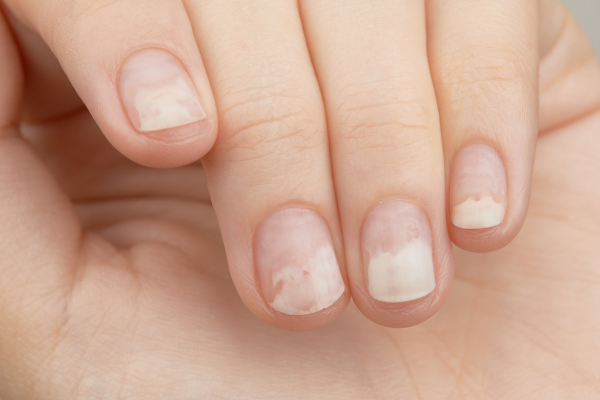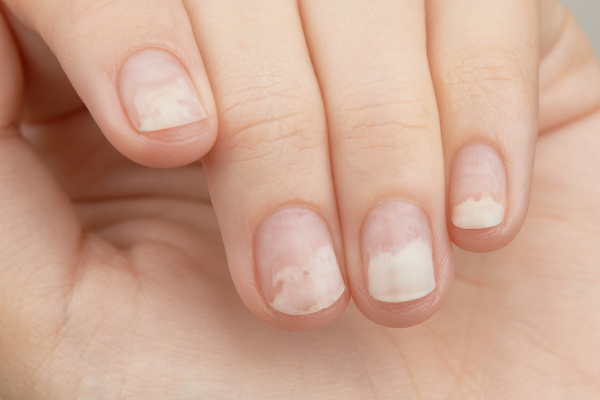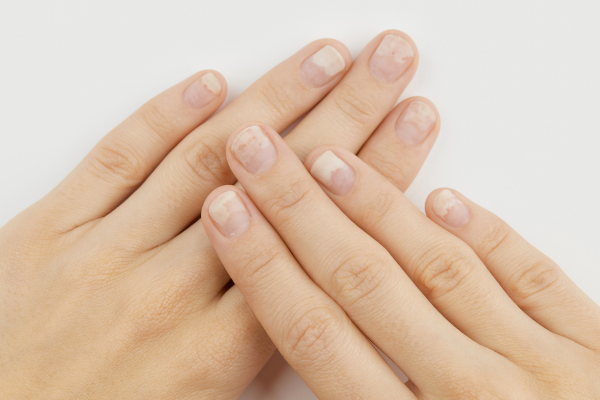Onycholysis of nails – what is it, how does it manifest itself and how can it be curbed?


Nail onycholysis is an unsightly condition resulting from the spontaneous separation of the nail plate from the nail bed. It can usually be combated quickly by acting immediately after detecting the problem. However, ignoring onycholysis will probably lead to unpleasant consequences, such as more serious nail diseases. What is nail onycholysis? What are its causes and symptoms? Finally, how can it be treated so that its actions are effective and the results are quick? Welcome to the compendium of knowledge about nail onycholysis.
What is nail onycholysis and what does it do?
Nail onycholysis is more of a condition than a nail disease. What does it look like? The nail plate separates from the nail bed that holds it. The detachment progresses from the free edge or side of the nail inwards and is visually manifested as a white discoloration on the nail in the place or several places where the nail plate comes away from the nail bed.
Onycholysis in the early stages does not cause any pain and does not pose a threat to human health. When we receive a diagnosis of this nail disease, we should treat it promptly to avoid the accumulation of dirt under the unattached part of the nail plate. Bacterial infections or nail fungus are possible consequences of retained moisture and an unfavorable environment for maintaining cleanliness.
Where does it come from? Causes of nail onycholysis
Many factors cause nail onycholysis. We divide them into genetic and acquired. Below we have described some of the most popular causes of this nail disease.
- Health reasons
Onycholysis may occur due to the body's weakening due to the development of numerous diseases or ailments. In addition to diseases of fungal, bacterial, or parasitic origin, nails are negatively affected by dermatological diseases (e.g., AZS—atopic dermatitis, psoriasis), anemia, diabetes, and health problems related to improper thyroid gland functioning. - Mechanical injuries
Mechanical injuries are the most common cause of the development of nail onycholysis. By hitting or prying the nails, this condition often occurs almost immediately. People with long nails should be especially careful, especially those growing upwards.
Onycholysis is often also a consequence of sawing the tile. If we disturb it too much, weakening it and negatively impacting its structure, it will become thinner and thinner and may separate from the placenta at any time.
Unfortunately, not everyone pays attention to wearing comfortable, not-too-tight shoes. Shoes that pinch your toes are another cause of injuries leading to onycholysis. Pinched toenails, often inappropriately shortened, can cause the nail plate to peel off quickly. - Improper application or removal of nail styling
Correct removal of hybrid styling is as important as its professional, hygienic making. Removing a hybrid manicure or pedicure using force, e.g. prying the hybrid with other nails or teeth, harms the nail plate and causes numerous problems, including onycholysis.
Traumatic onycholysis, especially on problematic, weak nails, may also be caused by mechanical damage to the nail plate caused by the overuse of coarse-grained files or poorly selected cutters. Improper hardening in a UV/LED lamp or improperly applied hybrid products also hurt the structure of nails, often leading to the development of onycholysis. - Reaction to chemicals or medications
By using strong chemicals in combination with water (e.g. a damp cloth soaked in a cleaning agent full of chemicals), we create conditions ideal for developing onycholysis, especially if we tend this type of disease. Therefore, before starting cleaning, it is worth using protective gloves.
Taking certain types of medications can also directly contribute to the occurrence of onycholysis. Here we distinguish anti-inflammatory agents, contraception, retinoids, tetracycline and chemotherapy - Pregnancy
Pregnancy brings various, often revolutionary, changes to the female body. Some are positive—glowing skin or thick hair—while others are negative. In some women, onycholysis occurs during pregnancy or immediately after birth, but it is usually temporary and does not recur.
Symptoms of nail onycholysis. How to recognize it? Does it cause pain?
Onycholysis itself should not cause pain, but it depends on its cause. If a mechanical injury precedes the condition, it may be accompanied by pain or discomfort of varying intensity.
What are the most common symptoms of onycholysis?
- Visible separation of the nail plate from the nail bed
- White discoloration of the detached part of the nail, resulting from loss of contact with the nail bed
- Accumulation of dirt under a detached nailIncreased humidity under the nail favors the growth of microorganisms
- Change in nail color to yellowish, greenish, brown, or black (in case of secondary bacterial or fungal infection)
- Pain and discomfort are possible, especially with advanced stages or infectionThickening of the nail plate
- Possible unpleasant odor due to developing infections under the nail
Check: Green bacteria on the nail – how to treat It? What is Pseudomonas aeruginosa?
Onycholysis – how to treat it?
Nail onycholysis can take various forms, and its severity depends, among other things, on the pace of reaction to the occurrence of a disease or the cause that led to its development. Onycholysis can be effectively treated both with home remedies and specialists. The most important thing is to choose a treatment method depending on its severity.
If onycholysis in your case is caused by damage to the nail plate during the application or removal of hybrid or gel nails and no disturbing symptoms appear other than the detachment of the nail plate from the nail bed, it is often enough to shorten the nail as much as possible and wait for it to grow back - new and completely healthy. In the case of fingernails, the regrowth time is about six months, and in the case of toenails, it takes up to a year.
To strengthen the growing nail and accelerate its growth, you can use a good quality nail conditioner, shorten your nails conscientiously and carefully take care of their hygiene. However, if you discover your problem too late or find home remedies insufficient, consult a dermatologist or podiatrist. These types of specialists will make a diagnosis and propose professional medical treatments. In some cases, surgical intervention in the form of removal of the nail plate may be necessary. However, such situations occur very rarely.

Onycholysis – how to prevent it?
Here are 7 simple and effective ways to prevent the development of nail onycholysis:
- Try to avoid mechanical injuries to your nails.
- Take care of the hygiene and care of your nails - trim them regularly and clean them thoroughly every day.
- When cleaning, wear protective gloves.
- After washing your hands, always wipe them dry. Humid environments favor the development of many nail diseases.
- Hygienically and carefully perform manicure and pedicure treatments. Equally, carefully remove the hybrid or gel from your nails.
- Keep devices and accessories used around your nails clean.
- Monitor the condition of your hands and feet to detect onycholysis
Onycholysis of nails – frequently asked questions
- Is it possible to create a hybrid with onycholysis?
During onycholysis treatment, hybrid manicure and pedicure should be avoided. Following your doctor's or podiatrist's recommendations will give you quick results and you will soon be able to enjoy beautiful hybrid styles again! - Is onycholysis contagious?
Onycholysis is not an infectious disease. If the separation of the nail plate from the nail bed is caused by nail fungus or another infection, you can, of course, become infected with the disease. However, these conditions are relatively rare causes of onycholysis itself - How long does onycholysis treatment take?
It all depends on its cause and the degree of advancement of the disease. Treatment time is usually from several weeks to several months.





